
Overview
This article delineates the critical distinctions between Bing Ads and Google Ads, particularly for direct-to-consumer (DTC) brands. It asserts that Google Ads provides a broader reach and a variety of ad formats, appealing to a wide audience. In contrast, Bing Ads emerges as a cost-effective alternative, characterized by lower competition and unique targeting capabilities. These features position Bing Ads as an advantageous option for DTC brands seeking to refine their advertising strategies and enhance their return on investment (ROI). By understanding these differences, DTC brands can make informed decisions that optimize their advertising efforts.
Introduction
The digital advertising landscape is evolving rapidly, presenting direct-to-consumer (DTC) brands with a myriad of choices for reaching their target audiences. Among these options, Bing Ads and Google Ads stand out, each offering unique advantages that can significantly impact a brand's visibility and profitability. This article delves into the key differences between these two platforms, revealing how DTC brands can leverage their distinct features to enhance conversion rates and optimize advertising spend. With the stakes high in a competitive market, the question remains: which platform will deliver the best results for specific business objectives?
Parah Group: Expert Conversion Rate Optimization for DTC Brands
Parah Group stands at the forefront of Conversion Rate Optimization (CRO) specifically designed for direct-to-consumer (DTC) companies, focusing on enhancing profitability without increasing advertising costs. Their methodologies are rooted in data-driven insights and a profound understanding of consumer psychology, leading to significant improvements in conversion rates and average order values for their clients. Notably, companies that have partnered with Parah Group have experienced a remarkable 36% increase in ROI on advertisements, alongside substantial enhancements in average order value (AOV) and conversion rates.
As the DTC landscape transforms, with projections suggesting that DTC e-commerce sales will soar to USD159.76 billion by 2024, the necessity for effective CRO strategies becomes increasingly critical. Parah Group adopts a holistic approach, ensuring that every aspect of a client's website and marketing strategy is optimized for growth. They adeptly address challenges such as high traffic costs and low conversion rates, positioning themselves as an essential ally for DTC companies navigating the intricacies of digital advertising, particularly in the context of bing vs google ads. This expertise is particularly vital in that differentiate various platforms, such as one search engine from another.
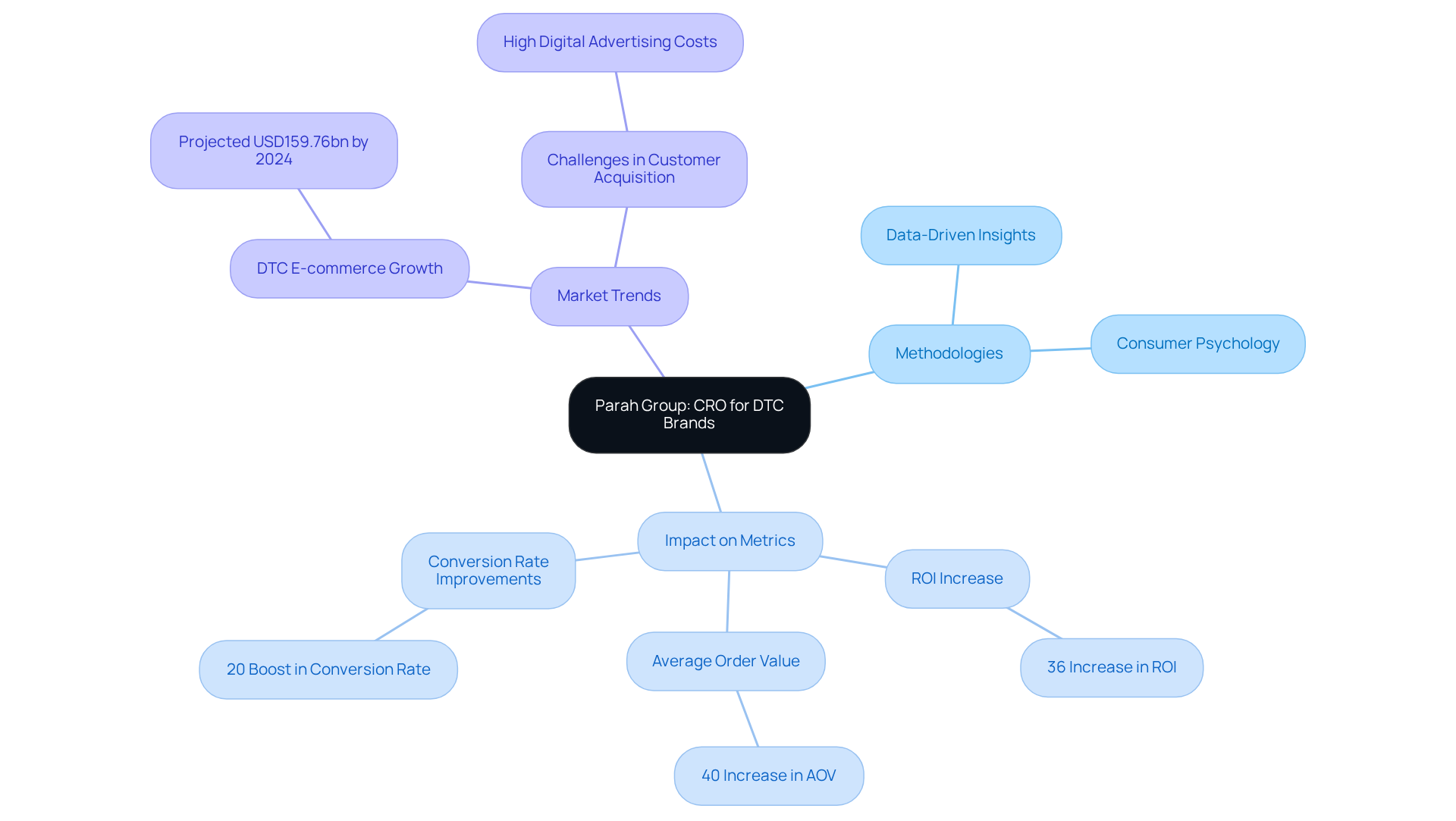
Reach: Bing Ads vs Google Ads
The advertising platform commands an impressive reach, capturing approximately 91.20% of the search engine market share, while its closest competitor accounts for about 5%. This substantial disparity allows Google Ads to provide unparalleled access to a broader audience, making it the optimal choice for companies striving to .
Conversely, the smaller audience of the competing search engine may lead to reduced competition for ad placements, potentially resulting in higher engagement rates within specific niches. Furthermore, this search engine's approach to local inquiries facilitates a wider search area, which can be advantageous for companies targeting particular demographics.
Notably, users of this search engine are typically older and more affluent, presenting a unique opportunity for DTC brands to engage with this audience effectively. As Ishan Gupta emphasizes, integrating search engine advertisements into a marketing strategy can unlock additional revenue channels, making it a valuable complement to the expansive reach of online ads.
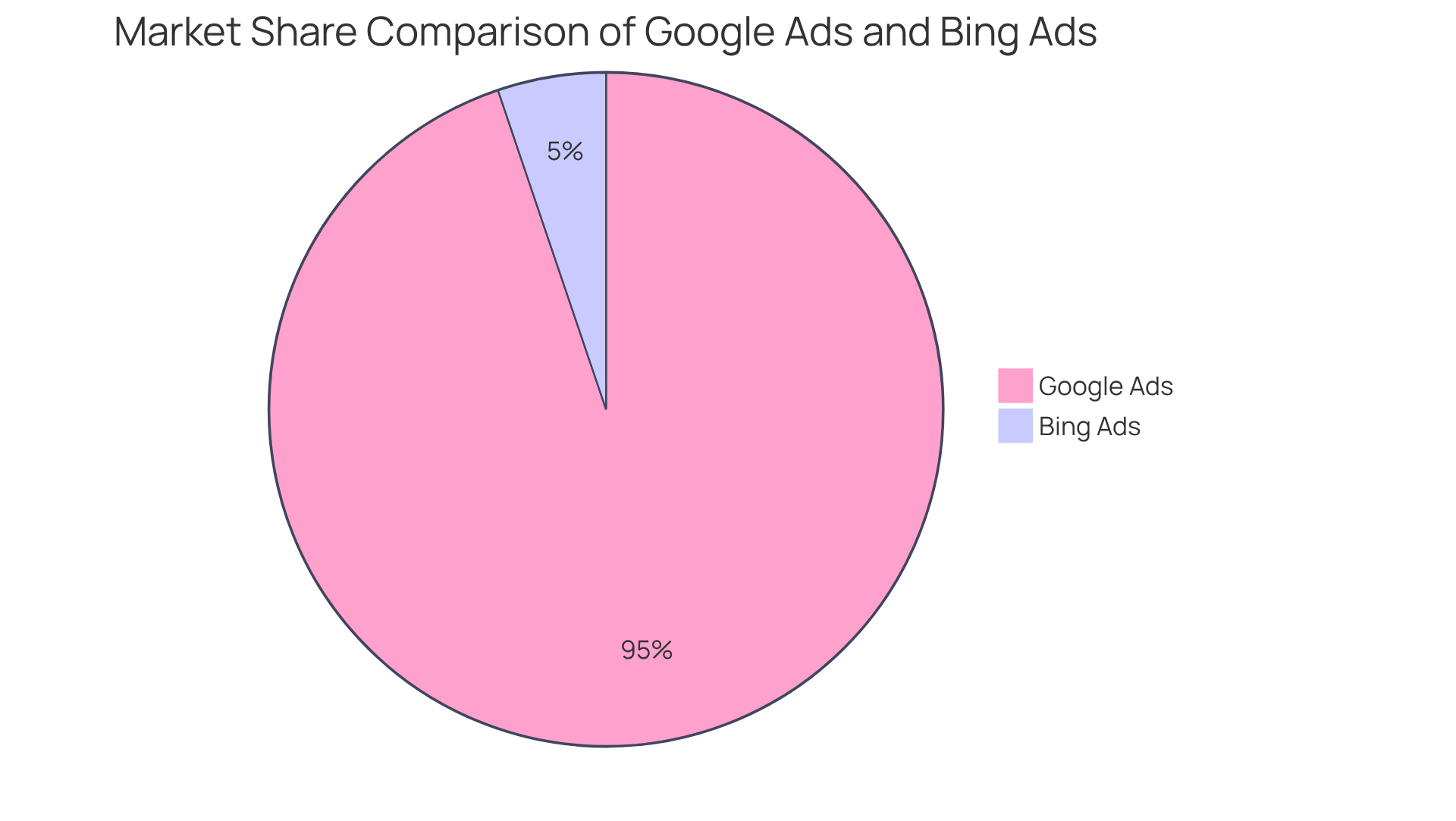
Demographics: Targeting Options in Bing Ads and Google Ads
Search engine advertising platforms like Bing vs Google Ads present robust demographic targeting features, yet they differ significantly in their functionalities.
- Google Ads empowers advertisers to target audiences by age, gender, and interests, making it effective for reaching a broad demographic.
- Conversely, Bing excels with more granular targeting capabilities, including device type and geographic location, which can be particularly advantageous for DTC brands striving to connect with specific demographics.
- Notably, over 70% of users on Bing are aged 35 or older, many of whom possess greater purchasing power, rendering it an ideal platform for .
- Moreover, Bing typically boasts a lower average cost-per-click (CPC) of approximately $1.54, compared to Google Ads' CPC of about $4.66, enhancing its cost-effectiveness for advertisers.
- Marketing experts advocate for a hybrid approach that leverages both Bing vs Google Ads to amplify ROI and foster ongoing growth, particularly for DTC companies looking to refine their advertising strategies in 2025 and beyond.
- Additionally, Bing’s LinkedIn integration serves as a powerful tool for engaging older, wealthier demographics, further enhancing its targeting capabilities.
- By employing expert Conversion Rate Optimization strategies from agencies like Parah Group, DTC brands can ensure their advertising efforts not only reach the appropriate audience but also convert effectively, thereby driving sustainable profitability and growth.
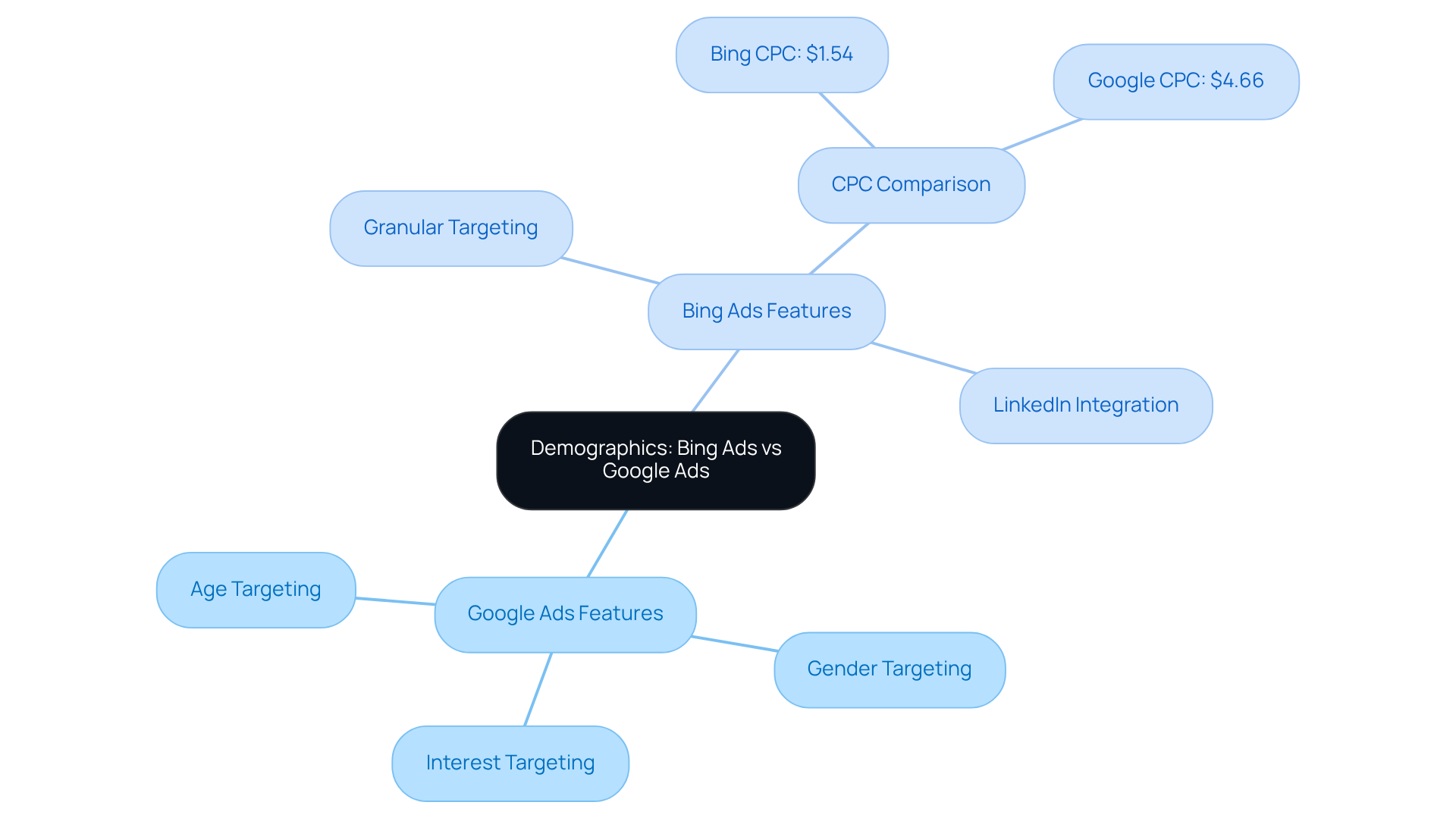
Keyword Targeting: Bing Ads vs Google Ads
Ads from the tech giant offer a comprehensive keyword targeting system, featuring a variety of match types, including broad, phrase, and exact matches. Conversely, this advertising platform presents similar options, typically at a lower competition level, which can result in more cost-effective campaigns when comparing Bing vs Google Ads. Notably, a specific advertising platform showcases a 20% lower cost-per-acquisition compared to Bing vs Google Ads, with an average CPC of $1.45 compared to Google Ads’ $2.85.
DTC companies must carefully consider their keyword strategies and how these align with their target audience's search behavior on each platform. Current trends indicate that DTC companies are increasingly recognizing the value of search advertisements in gaining competitive advantages through strategic keyword targeting, particularly in niche markets where competition is less fierce.
SEO experts emphasize that is crucial for DTC companies, as it directly influences campaign performance and cost efficiency.
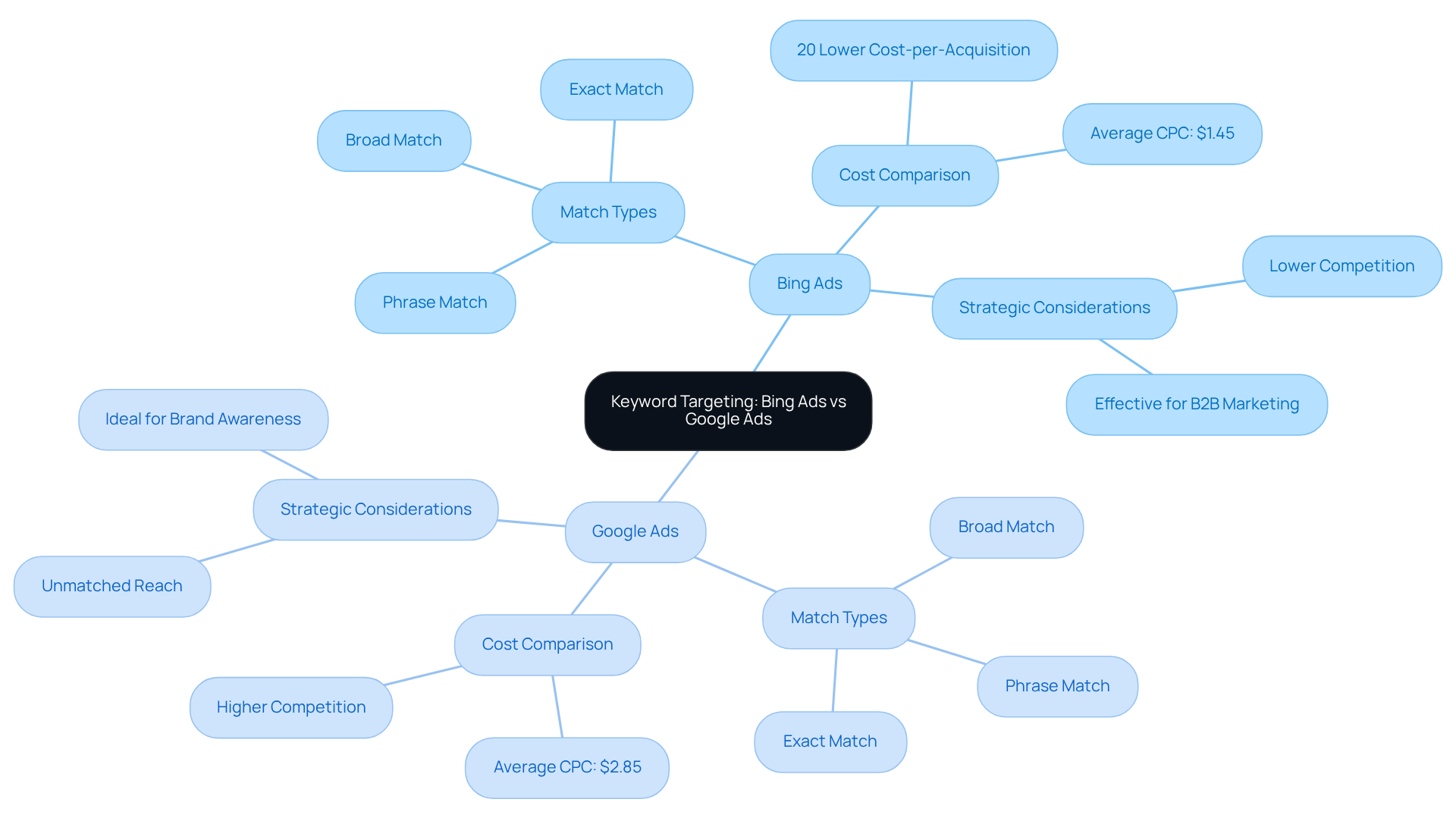
Cost Per Click: Analyzing Bing Ads and Google Ads
In 2025, the average cost per click (CPC) for Microsoft Ads is approximately $1.54, which is significantly lower when comparing Bing vs Google Ads, where the average CPC is around $2.85. This notable disparity presents a compelling opportunity for operating on tighter budgets, allowing them to achieve comparable, if not superior, results at a reduced cost.
For instance, companies leveraging search engine advertisements can optimize their advertising budgets, facilitating a broader reach and enhanced interaction without straining their financial resources. Notably, this advertising platform boasts an average conversion rate of 2.94%, slightly exceeding that of other services, thereby reinforcing its efficiency.
It is imperative for companies to evaluate their CPC alongside the average cost per acquisition (CPA) of $41.44 for Bing vs Google Ads, which is approximately 30% lower than Google Ads, in relation to their overarching advertising objectives.
Digital marketing specialists underscore that understanding these cost dynamics is essential for DTC companies aiming to bolster profitability while navigating competitive landscapes. As a practical recommendation, DTC brand owners should routinely assess their advertising strategies based on CPC, conversion rates, and CPA to ensure they are maximizing their return on investment.
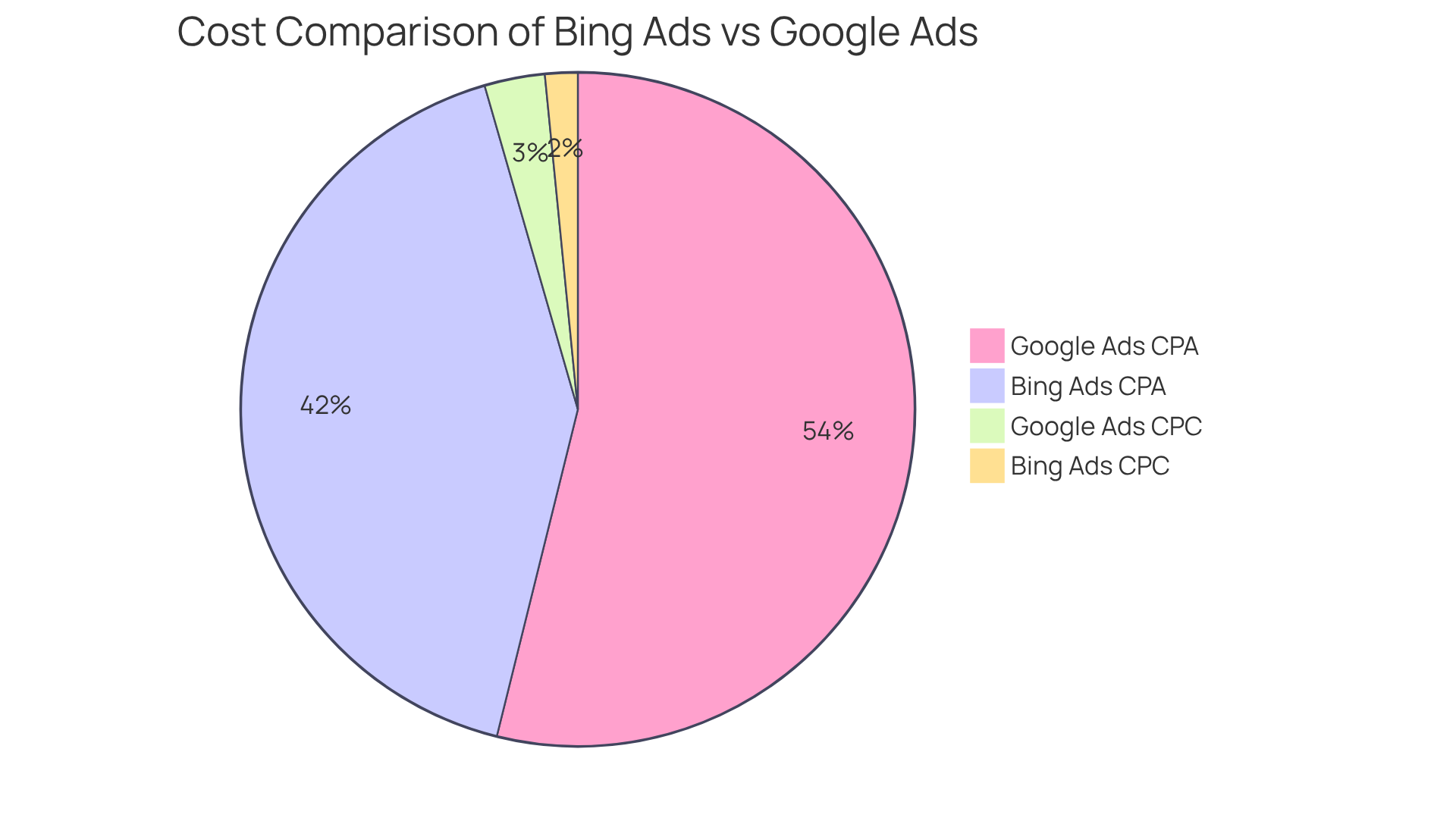
Click-Through Rates and Conversion Rates: Comparing Platforms
Click-through rates on Microsoft Advertising average around 2.83%, significantly higher than the search engine's 1.91%. This indicates that, despite a lower overall reach, Microsoft Advertising's ads resonate more effectively with its audience. Moreover, this platform typically boasts higher conversion rates, averaging 3.75% compared to the other search engine's 2.94%.
It's crucial to recognize that Google Ads often incurs a greater cost per conversion, an essential consideration for DTC companies managing their advertising budgets. Additionally, Ads users tend to be older and more affluent, impacting the decision-making process for DTC companies targeting specific customer segments.
Therefore, DTC companies should carefully evaluate these metrics to determine which platform, specifically in the context of , aligns best with their conversion objectives. As Charlotte Evans, a Lead Performance Marketer, asserts, 'When considering Bing vs Google Ads, Bing Ads usually provides better ROI if your budget is smaller or your industry is niche.'
Consequently, testing both platforms with small campaigns can empower brands to compare results and refine their advertising strategies.

Ad Formats: Bing Ads vs Google Ads
Google Ads excels in offering a diverse array of ad formats, including:
- Search ads
- Display ads
- Video ads
- Shopping ads
These formats cater to various marketing strategies and audience engagement needs. In contrast, Bing Ads, now known as Microsoft Advertising, features unique options such as:
- Multimedia ads
- Responsive search ads
These can be particularly effective for reaching specific demographics. Direct-to-consumer (DTC) companies must carefully evaluate which ad formats align with their marketing objectives and resonate with their target audience. Utilizing the right format can lead to in engagement and conversion rates. For instance, Shopping Ads on Google boast conversion rates of up to 6.96%, making them particularly effective for product-focused campaigns. As advertising experts observe, the selection of ad format can significantly influence engagement, highlighting the need for companies to customize their strategies to enhance effectiveness across both platforms.
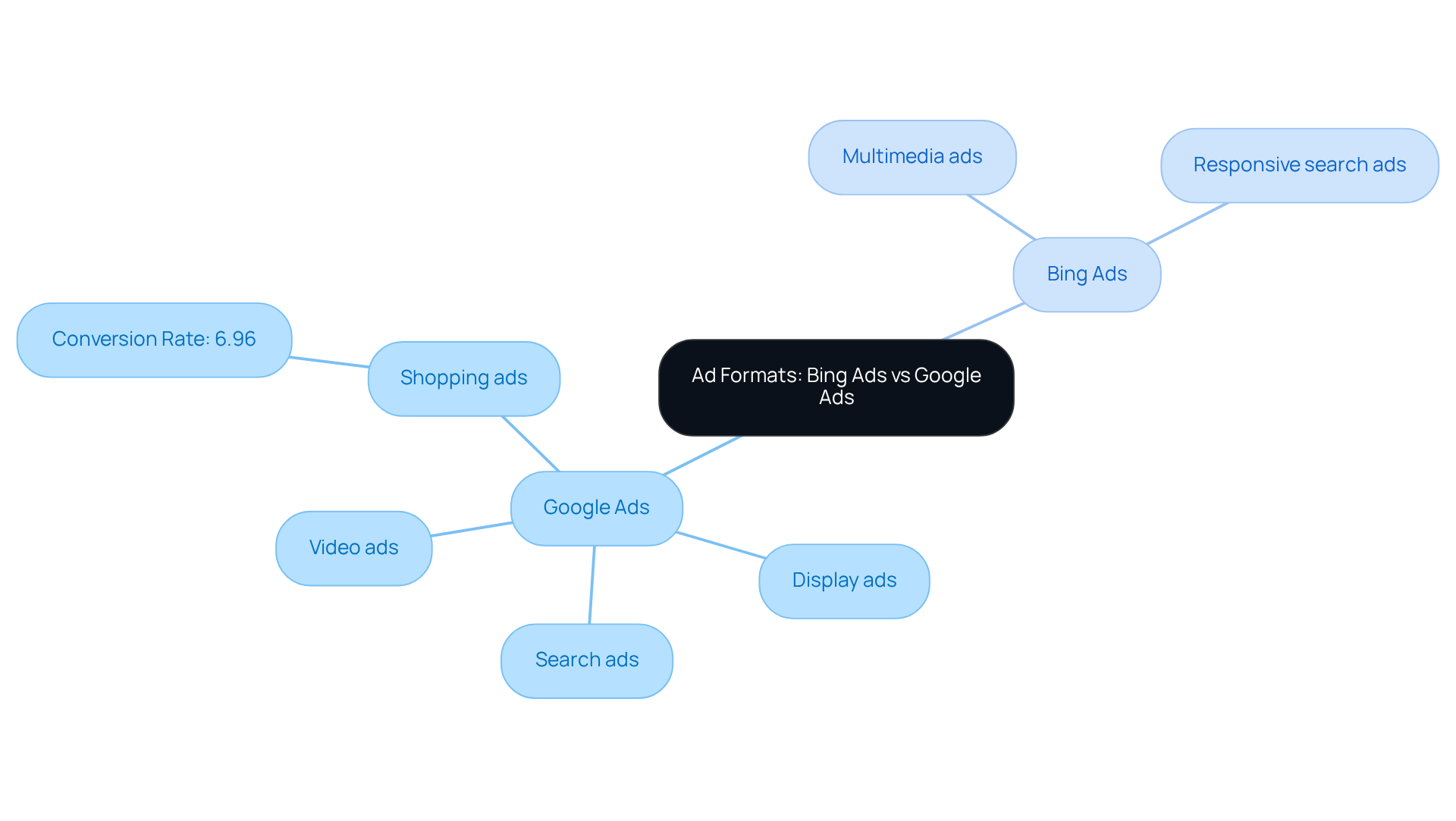
Unique Benefits of Bing Ads for DTC Brands
Bing Ads offers distinct advantages for DTC companies, particularly through its reduced competition, which fosters greater visibility and engagement. This lower competition allows companies to achieve higher click-through and conversion rates, enhancing the effectiveness of their advertising efforts. For example, a $30M apparel company that collaborated with Parah Group experienced a 35% increase in conversion rates following strategic adjustments, illustrating the power of targeted advertising in driving results.
Moreover, the integration of Bing with LinkedIn facilitates targeted advertising towards professionals, positioning it as an optimal platform for B2B-oriented DTC companies. This capability empowers advertisers to connect directly with decision-makers, significantly boosting the potential for conversions.
The cost-effectiveness of this advertising platform further enables companies to optimize their promotional budgets. With significantly lower in the comparison of Bing vs Google Ads—£0.62 on Bing compared to £1.30 on Google—DTC companies can achieve superior results without overspending. This strategic advantage allows companies to allocate resources more efficiently, ultimately enhancing their return on ad spend (ROAS). For instance, Grab Green, a $15M revenue cleaning product company, increased their average order value by 80% through optimized pricing strategies, demonstrating how effective advertising can lead to substantial financial gains.
As digital marketing specialists note, the unique placement of these advertisements allows companies to reach demographics often overlooked by competitors, ensuring their messages resonate with the right audience. By embracing online advertisements, DTC companies can not only enhance their visibility but also cultivate a more engaged customer base, paving the way for sustainable growth. To effectively leverage Bing Ads, DTC companies should concentrate on refining their ad copy and targeting strategies to fully harness the platform's advantages.
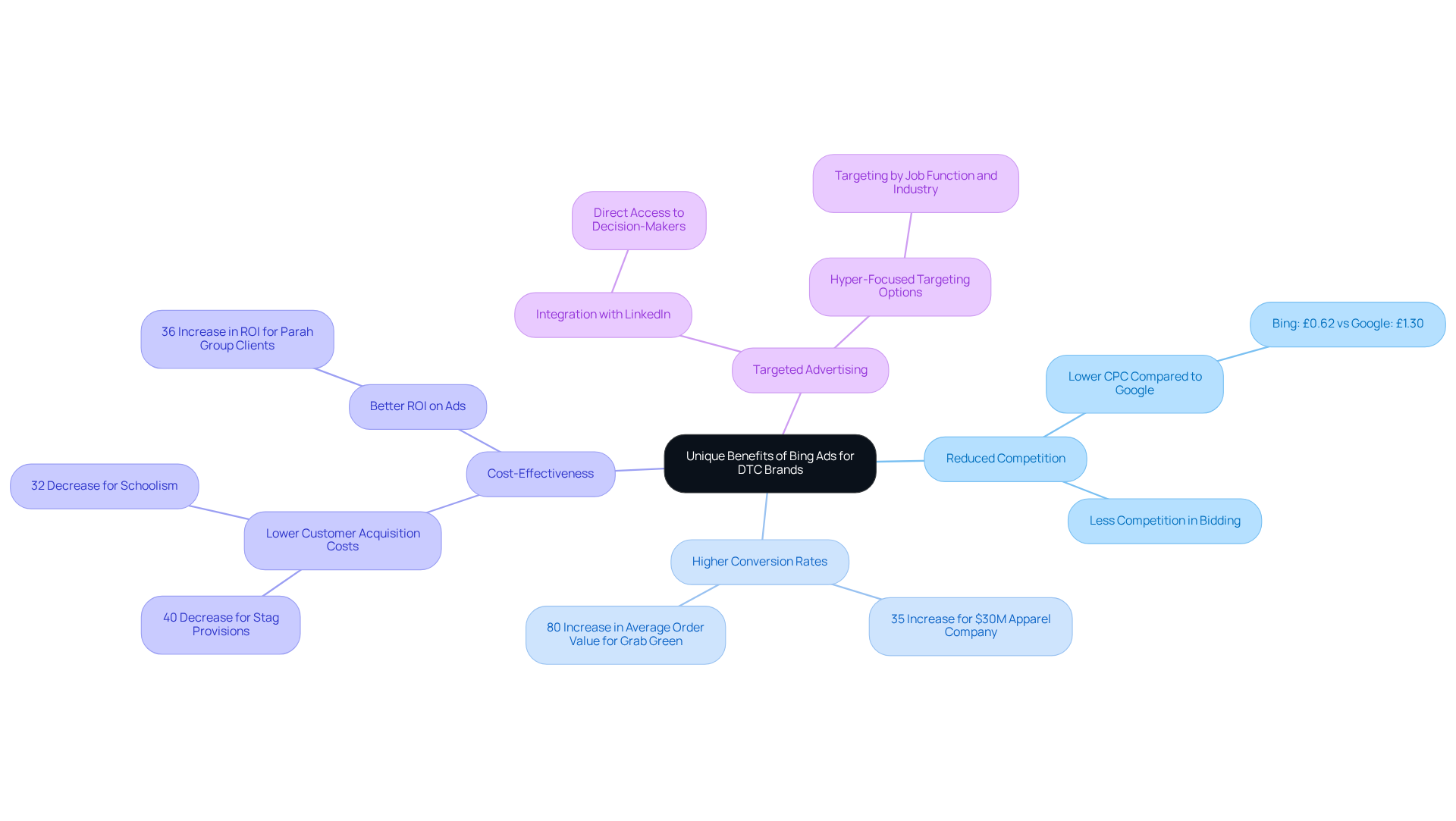
Integration Capabilities: Bing Ads and Google Ads
Ads from the tech giant facilitate seamless integration with various services, such as Analytics and Tag Manager, which enables comprehensive tracking and analysis. Notably, integration with Analytics has been shown to boost conversions by 5% for advertisers who implement it, establishing it as a vital resource for DTC companies seeking to enhance their marketing strategies.
Furthermore, the advertising platform presents diverse integration options, including the ability to import campaigns from other ad services, streamlining the management of promotional activities across multiple platforms.
Marketing professionals assert that effective campaign management tools are essential for maximizing ROI and achieving sustainable growth in a competitive environment.
Recent enhancements from a leading tech company and further empower advertisers with greater control and efficiency, highlighting the critical role of these integrations in formulating a robust marketing strategy.
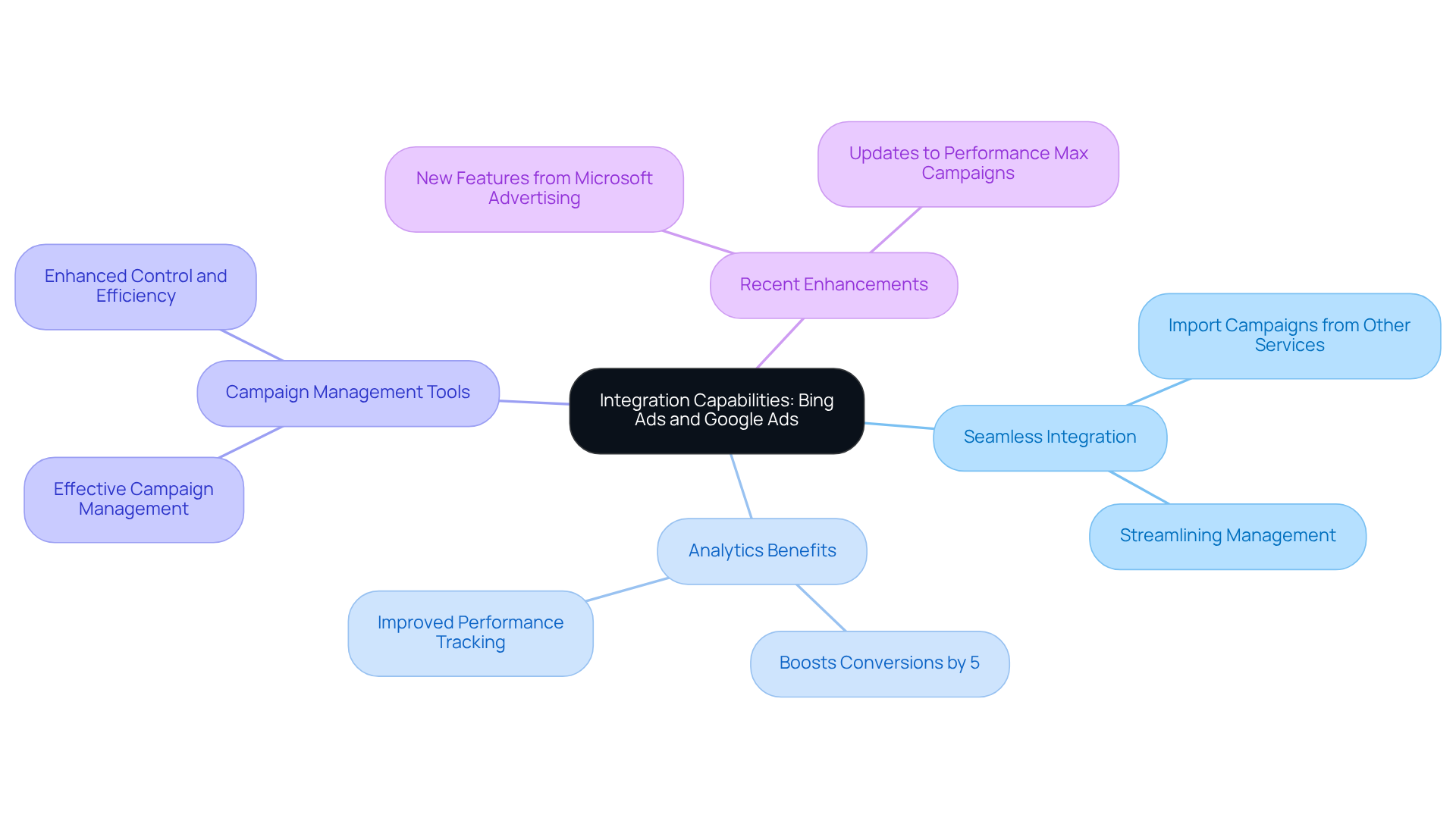
Choosing Between Bing Ads and Google Ads: A Strategic Approach
When selecting between , such as Bing vs Google Ads, DTC companies must conduct a thorough assessment of their target audience, budget, and marketing objectives. Advertising services, with its extensive reach and commanding market share of 76%, is particularly suited for companies aiming to connect with a broader audience, boasting an impressive average conversion rate of 3.75%.
Conversely, Microsoft Advertising, which captures a market share of 2.69% and offers a cost-per-click (CPC) of approximately $1.54, presents a cost-effective solution with reduced competition, making it especially appealing for companies operating within tighter budget constraints.
Recent trends suggest that a hybrid advertising strategy, leveraging both platforms, can significantly enhance visibility and engagement across diverse consumer segments. A compelling case study revealed that a mid-sized clothing retailer experienced a remarkable combined ROI increase of 47% by utilizing both online advertising platforms. This approach not only maximizes reach but also empowers companies to tailor their messaging and targeting to align with the distinctive characteristics of each platform's user base.
For example, in the comparison of Bing vs Google Ads, Google Ads excels in attracting younger demographics, while Bing Ads effectively targets older, affluent audiences, particularly in B2B contexts. As Ishan Gupta, an SEO expert, aptly noted, "These demographic differences create unique opportunities for advertisers to reach specific audience segments."
By implementing a dual-platform strategy, DTC companies can optimize their advertising efforts, ensuring they capture the attention of various audience segments while managing costs effectively. To successfully execute this strategy, brands should consistently analyze performance metrics from both platforms and adjust their campaigns based on audience engagement and conversion rates.
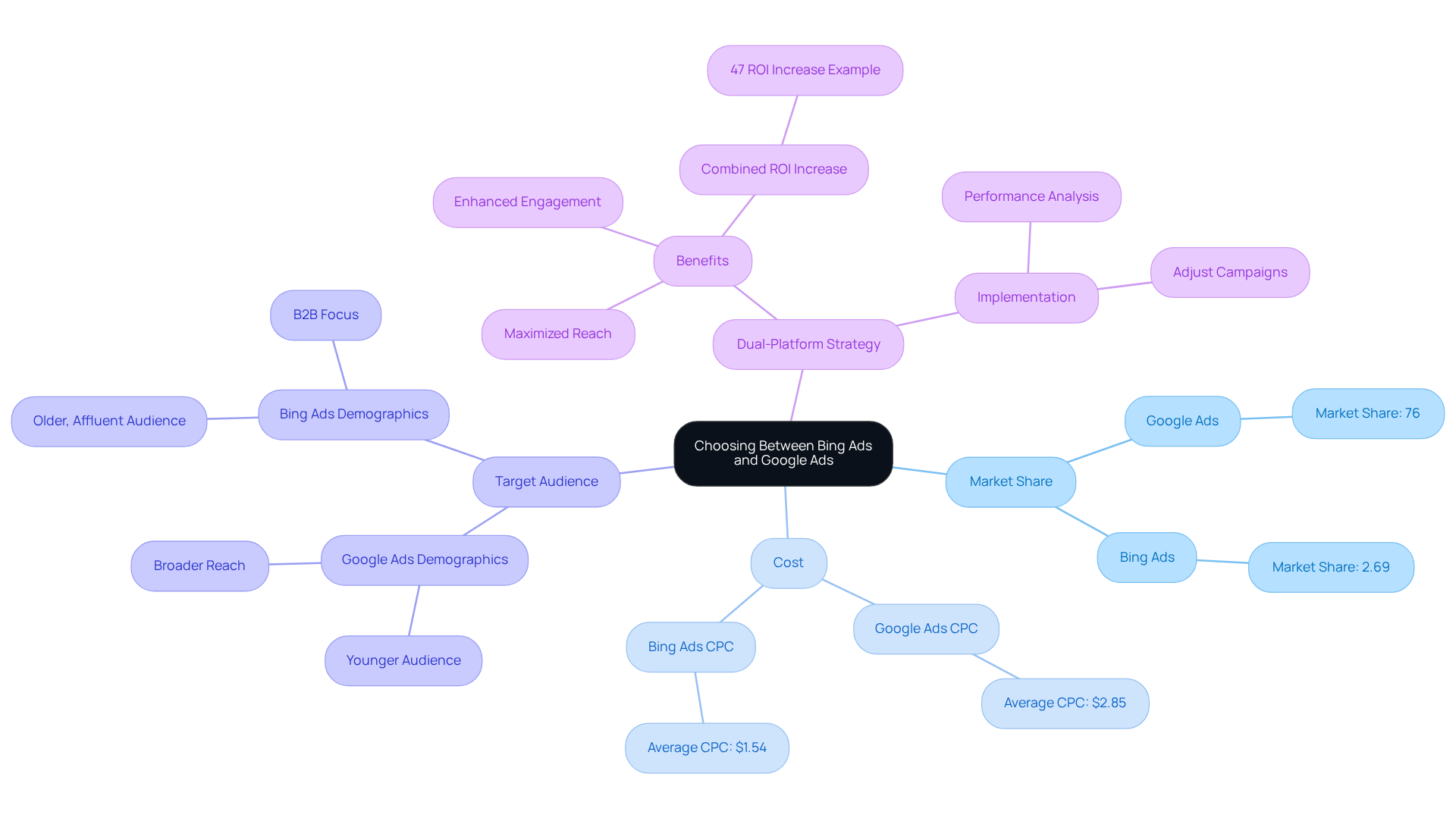
Conclusion
Bing Ads and Google Ads offer distinct opportunities for direct-to-consumer (DTC) brands, each presenting unique strengths and weaknesses. A comprehensive understanding of these differences is vital for brands seeking to optimize their advertising strategies and maximize return on investment. By leveraging the advantages of both platforms, DTC companies can effectively reach their target audiences while managing costs and enhancing conversion rates.
This article has examined key differences between Bing and Google Ads, focusing on:
- Reach
- Demographics
- Keyword targeting
- Cost per click
- Ad formats
Notably, Bing Ads provides a lower cost per click and faces less competition, making it an appealing choice for brands operating with tighter budgets. In contrast, Google Ads shines in audience reach and offers diverse ad formats, catering to a broader demographic. The integration capabilities of both platforms further enhance their effectiveness, facilitating comprehensive tracking and campaign management.
In a rapidly evolving digital landscape, DTC brands must remain agile and informed about the advertising platforms at their disposal. A hybrid approach that combines the strengths of both Bing and Google Ads can lead to improved visibility and engagement across various consumer segments. By continuously analyzing performance metrics and refining their strategies, brands can harness the full potential of these platforms to drive sustainable growth and profitability. Embracing these insights will empower DTC companies to navigate the complexities of digital advertising and achieve lasting success.
Frequently Asked Questions
What is Parah Group and what do they specialize in?
Parah Group is an expert in Conversion Rate Optimization (CRO) specifically for direct-to-consumer (DTC) brands, focusing on enhancing profitability without increasing advertising costs.
How does Parah Group improve conversion rates for its clients?
Parah Group utilizes data-driven insights and a deep understanding of consumer psychology to significantly improve conversion rates and average order values for their clients.
What results have companies experienced after partnering with Parah Group?
Companies that have partnered with Parah Group have seen a remarkable 36% increase in ROI on advertisements, along with substantial improvements in average order value (AOV) and conversion rates.
Why is Conversion Rate Optimization important for DTC brands?
As DTC e-commerce sales are projected to reach USD159.76 billion by 2024, effective CRO strategies are crucial for enhancing profitability and navigating the complexities of digital advertising.
How does Parah Group address challenges faced by DTC companies?
Parah Group adopts a holistic approach to ensure that every aspect of a client's website and marketing strategy is optimized for growth, tackling issues like high traffic costs and low conversion rates.
What is the market share difference between Bing Ads and Google Ads?
Google Ads captures approximately 91.20% of the search engine market share, while its closest competitor accounts for about 5%, providing broader audience access.
What are the advantages of using Bing Ads for specific demographics?
Bing Ads has a smaller audience which may result in reduced competition for ad placements, potentially leading to higher engagement rates within specific niches. Users of Bing are typically older and more affluent, presenting a unique opportunity for DTC brands.
How do the demographic targeting options differ between Bing Ads and Google Ads?
Google Ads allows targeting by age, gender, and interests for a broad demographic reach, while Bing offers more granular targeting options, including device type and geographic location, which can be beneficial for reaching specific demographics.
What is the average cost-per-click (CPC) for Bing Ads compared to Google Ads?
Bing typically has a lower average CPC of approximately $1.54, while Google Ads' average CPC is about $4.66, making Bing more cost-effective for advertisers.
How can DTC brands effectively use both Bing and Google Ads?
Marketing experts recommend a hybrid approach that leverages both platforms to amplify ROI and foster growth, especially for DTC companies looking to refine their advertising strategies in the future.
How does LinkedIn integration enhance Bing's targeting capabilities?
Bing’s LinkedIn integration allows for better engagement with older, wealthier demographics, enhancing its effectiveness in targeting affluent audiences.
FAQs











